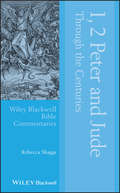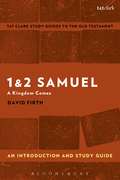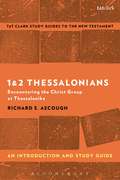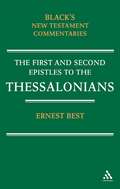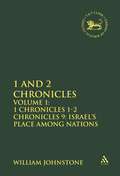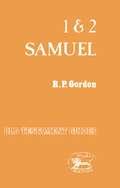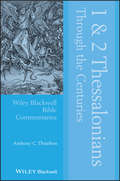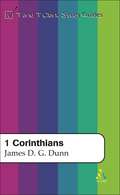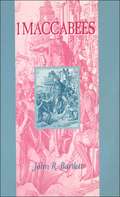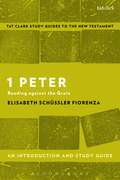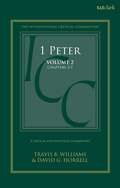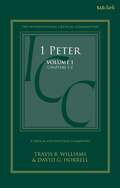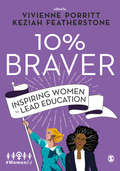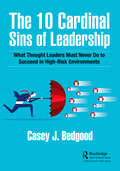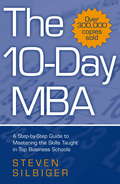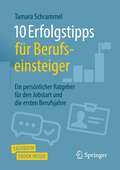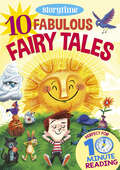- Table View
- List View
1, 2 Peter and Jude Through the Centuries (Wiley Blackwell Bible Commentaries)
by Rebecca SkaggsExplores the epistles’ reception history and their effects in sermons, music, art, literature, and politics over time 1, 2 Peter and Jude Through the Centuries considers three small epistles which are often overlooked in controversial discussions of theology, culture, art, music, politics, and literature. This book offers fresh perspectives on the epistles’ effects in numerous theological and cultural contexts such as slavery, the role of women in marriage, the nature of Christology, and how believers should relate to the government. Author Rebecca Skaggs traces the reception history of 1 Peter, Jude, and 2 Peter and investigates the texts’ effects on diverse doctrinal, social and political issues. Their influence on artists, musicians, dramatists and literary writers is explored, especially the Doctrine of the Descent of Christ into Hades. Each chapter includes an overview of central issues and topics, a selection of ancient readings with interpretations and a brief survey of modern scholarship on the subject. Illuminating how readings vary across historical periods and interpretive communities, this book: Traces the multi-faceted contributions of 1 and 2 Peter and Jude to theological discussions Provides a sampling of the kinds of effects available from each of the texts in various contexts Shows how the epistles engage in the discussions and controversies of the Medieval Ages Offers discussions of the epistles’ contributions to doctrinal debates on the inspiration of scripture and how to respond to heresy in the church Features detailed treatment of topics such as Christ’s visit to the spirits in prison, the dispute between Michael and Satan over Moses’ body and the final judgment by fire Features commentary from a leading scholar in New Testament Studies and Christian Theology Offering enlightening essays and new approaches, 1, 2 Peter and Jude Through the Centuries is an ideal book for anyone interested in the rich contributions of these epistles, such as Biblical and Theological Studies students, and pastors looking for original insights on reception material.
1, 2 Peter and Jude Through the Centuries (Wiley Blackwell Bible Commentaries)
by Rebecca SkaggsExplores the epistles’ reception history and their effects in sermons, music, art, literature, and politics over time 1, 2 Peter and Jude Through the Centuries considers three small epistles which are often overlooked in controversial discussions of theology, culture, art, music, politics, and literature. This book offers fresh perspectives on the epistles’ effects in numerous theological and cultural contexts such as slavery, the role of women in marriage, the nature of Christology, and how believers should relate to the government. Author Rebecca Skaggs traces the reception history of 1 Peter, Jude, and 2 Peter and investigates the texts’ effects on diverse doctrinal, social and political issues. Their influence on artists, musicians, dramatists and literary writers is explored, especially the Doctrine of the Descent of Christ into Hades. Each chapter includes an overview of central issues and topics, a selection of ancient readings with interpretations and a brief survey of modern scholarship on the subject. Illuminating how readings vary across historical periods and interpretive communities, this book: Traces the multi-faceted contributions of 1 and 2 Peter and Jude to theological discussions Provides a sampling of the kinds of effects available from each of the texts in various contexts Shows how the epistles engage in the discussions and controversies of the Medieval Ages Offers discussions of the epistles’ contributions to doctrinal debates on the inspiration of scripture and how to respond to heresy in the church Features detailed treatment of topics such as Christ’s visit to the spirits in prison, the dispute between Michael and Satan over Moses’ body and the final judgment by fire Features commentary from a leading scholar in New Testament Studies and Christian Theology Offering enlightening essays and new approaches, 1, 2 Peter and Jude Through the Centuries is an ideal book for anyone interested in the rich contributions of these epistles, such as Biblical and Theological Studies students, and pastors looking for original insights on reception material.
1 & 2 Samuel: A Kingdom Comes (T&T Clark’s Study Guides to the Old Testament)
by David FirthScholarly study of Samuel continues to wrestle with how we interpret this pivotal text. Even such basic matters as the question of what kind of literature it is remain unresolved while older questions such as the nature of its text and sources are debated anew in the light of material from Qumran and of current approaches to Hebrew narrative. Recognizing the importance of questions such as these, David Firth explores and introduces fresh ways of reading Samuel as a unified and yet complex text, which displays high levels both of literary artistry and of theological commitment.Although some stories in the books of Samuel are well known, and in the case of David and Goliath even proverbial, much of the content of these books is strange to modern readers. It is a story about a woman wanting a child, for example, that relates the beginnings of monarchy within Israel. Even the question of the monarchy is problematic, for we are introduced to not one royal family but two-those of Saul and David. David is ultimately shown to be the king chosen by God, yet by the end of the book he is only just managing to hold on to the kingdom as it is nearly torn from him by rivalries within his family. These arresting stories are perplexing, for Samuel's writers seldom tell us how to read and interpret them. Firth presents these complex and fascinating stories as part of a bigger picture, enabling students to chart their way through the literary and historical issues of the Samuel narrative. Firth addresses issues of historicity, sources, date and authorship, as well as -- crucially -- appreciating the text as a literary whole.
1 & 2 Samuel: A Kingdom Comes (T&T Clark’s Study Guides to the Old Testament)
by David FirthScholarly study of Samuel continues to wrestle with how we interpret this pivotal text. Even such basic matters as the question of what kind of literature it is remain unresolved while older questions such as the nature of its text and sources are debated anew in the light of material from Qumran and of current approaches to Hebrew narrative. Recognizing the importance of questions such as these, David Firth explores and introduces fresh ways of reading Samuel as a unified and yet complex text, which displays high levels both of literary artistry and of theological commitment.Although some stories in the books of Samuel are well known, and in the case of David and Goliath even proverbial, much of the content of these books is strange to modern readers. It is a story about a woman wanting a child, for example, that relates the beginnings of monarchy within Israel. Even the question of the monarchy is problematic, for we are introduced to not one royal family but two-those of Saul and David. David is ultimately shown to be the king chosen by God, yet by the end of the book he is only just managing to hold on to the kingdom as it is nearly torn from him by rivalries within his family. These arresting stories are perplexing, for Samuel's writers seldom tell us how to read and interpret them. Firth presents these complex and fascinating stories as part of a bigger picture, enabling students to chart their way through the literary and historical issues of the Samuel narrative. Firth addresses issues of historicity, sources, date and authorship, as well as -- crucially -- appreciating the text as a literary whole.
1 & 2 Thessalonians: Encountering the Christ Group at Thessalonike (T&T Clark’s Study Guides to the New Testament)
by Richard S. Ascough1 Thessalonians provides a fascinating glimpse into the origins and social life of the Christ group in the ancient Roman city of Thessalonike, while 2 Thessalonians reveals how the community developed at a somewhat later time. This guide narrates the story of the founding of the group by considering the social and cultural contexts, the literary form, the rhetorical strategies, the theologies, and the reception of the two canonical letters. While centering on the texts of 1 and 2 Thessalonians themselves, Ascough draws widely on literary and archaeological data, giving particular attention to typical group behaviours among small, unofficial associations in the Greek and Roman period. The first four chapters focus on 1 Thessalonians, from the initial formation of the Christ group out of a small association of artisans through to how members negotiated various sorts of relationships: with Paul and his companions, with outsiders in Thessalonike and beyond, and especially with fellow believers within the group itself. The final two chapters turn attention to the shifting circumstances that required a second letter to be written, with its focus on disorder and disruption of social practices and theological beliefs. The epilogue briefly surveys Christianity at Thessalonike beyond the 1st century. This guide presents an overview of the historical development of the Christ group at Thessalonike. Moving beyond treating the canonical letters as simple repositories of theological opinions, Ascough demonstrates how 1 and 2 Thessalonians reveal ordinary life in ancient Roman cities. In so doing, he invites readers to enter the world of one of the many fascinating communities of Christ believers in the 1st century of the Common Era.
1 & 2 Thessalonians: Encountering the Christ Group at Thessalonike (T&T Clark’s Study Guides to the New Testament)
by Richard S. Ascough1 Thessalonians provides a fascinating glimpse into the origins and social life of the Christ group in the ancient Roman city of Thessalonike, while 2 Thessalonians reveals how the community developed at a somewhat later time. This guide narrates the story of the founding of the group by considering the social and cultural contexts, the literary form, the rhetorical strategies, the theologies, and the reception of the two canonical letters. While centering on the texts of 1 and 2 Thessalonians themselves, Ascough draws widely on literary and archaeological data, giving particular attention to typical group behaviours among small, unofficial associations in the Greek and Roman period. The first four chapters focus on 1 Thessalonians, from the initial formation of the Christ group out of a small association of artisans through to how members negotiated various sorts of relationships: with Paul and his companions, with outsiders in Thessalonike and beyond, and especially with fellow believers within the group itself. The final two chapters turn attention to the shifting circumstances that required a second letter to be written, with its focus on disorder and disruption of social practices and theological beliefs. The epilogue briefly surveys Christianity at Thessalonike beyond the 1st century. This guide presents an overview of the historical development of the Christ group at Thessalonike. Moving beyond treating the canonical letters as simple repositories of theological opinions, Ascough demonstrates how 1 and 2 Thessalonians reveal ordinary life in ancient Roman cities. In so doing, he invites readers to enter the world of one of the many fascinating communities of Christ believers in the 1st century of the Common Era.
1 & 2 Thessalonians: 1 And 2 Thessalonians (Black's New Testament Commentaries)
by Ernest BestThe 1974 estimate by Interpretation that Ernest Best's volume on 1 & 2 Thessalonians "is probably the best exegetical study of 1 and 2 Thessalonians available … a superb commentary†? continues to ring true forty years later. This is indeed one of the finest commentaries on 1 & 2 Thessalonians available-in any language. The Journal of Theological Studies called it "exhaustive†? and concluded that the commentary is "reliable, judicious, and nearly always lucid. He [Best] … takes us as far as we can reasonably go in understanding the mind of Paul as it expressed itself in these writings.†?
1 and 2 Chronicles: Volume 2: 2 Chronicles 10-36: Guilt and Atonement (The Library of Hebrew Bible/Old Testament Studies)
by William JohnstoneThis two-part commentary argues that Chronicles, placed as it is among the 'historical books' in the traditional Old Testament of the Christian church, is much misunderstood. Restored to its proper position as the final book in the canon as arranged in the order of the Hebrew Bible, it is rather to be understood as a work of theology essentially directed towards the future. The Chronicler begins his work with the problem facing the whole human race in Adam-the forfeiture of the ideal of perfect oneness with God's purpose. He explores the possibility of the restoration of that ideal through Israel's place at the centre of the world of the nations. This portrayal reaches its climax in an idealized presentation of the reign of Solomon, in which all the rulers of the earth, including most famously the Queen of Sheba, bring their tribute in acknowledgment of Israel's status (Volume 1). As subsequent history only too clearly shows, however, the Chronicler argues (Volume 2), that Israel itself, through unfaithfulness to Torah, has forfeited its right to possession of its land and is cast adrift among these same nations of the world. But the Chronicler's message is one of hope. By a radical transformation of the chronology of Israel's past into theological terms, the generation whom the Chronicler addresses becomes the fiftieth since Adam. It is the generation to whom the jubilee of return to the land through a perfectly enabled obedience to Torah, and thus the restoration of the primal ideal of the human race, is announced.
1 and 2 Chronicles: Volume 1: 1 Chronicles 1-2 Chronicles 9: Israel's Place among Nations (The Library of Hebrew Bible/Old Testament Studies)
by William JohnstoneThis two-part commentary argues that Chronicles, placed as it is among the 'historical books' in the traditional Old Testament of the Christian church, is much misunderstood. Restored to its proper position as the final book in the canon as arranged in the order of the Hebrew Bible, it is rather to be understood as a work of theology essentially directed towards the future. The Chronicler begins his work with the problem facing the whole human race in Adam-the forfeiture of the ideal of perfect oneness with God's purpose. He explores the possibility of the restoration of that ideal through Israel's place at the centre of the world of the nations. This portrayal reaches its climax in an idealized presentation of the reign of Solomon, in which all the rulers of the earth, including most famously the Queen of Sheba, bring their tribute in acknowledgment of Israel's status (Volume 1). As subsequent history only too clearly shows, however, the Chronicler argues (Volume 2), that Israel itself, through unfaithfulness to Torah, has forfeited its right to possession of its land and is cast adrift among these same nations of the world. But the Chronicler's message is one of hope. By a radical transformation of the chronology of Israel's past into theological terms, the generation whom the Chronicler addresses becomes the fiftieth since Adam. It is the generation to whom the jubilee of return to the land through a perfectly enabled obedience to Torah, and thus the restoration of the primal ideal of the human race, is announced.
1 and 2 Samuel (Old Testament Guides)
by Robert P. GordonA comprehensive introduction to the critical issues raised by scholarship on both books of Samuel. The often intricate problems are dealt with clearly and engagingly; the chapters deal with the Deuteronomistic History, the Shiloh tradition, the Ark narrative, the rise of the monarchy, the reign of Saul, the story of David, the Davidic covenant, the Succession Narrative and the Samuel appendix. A first-rate guide for students, with annotated bibliographies and indexes.
1 and 2 Thessalonians Through the Centuries (Wiley Blackwell Bible Commentaries)
by Anthony C. ThiseltonThis unique commentary on Paul’s early letters by an outstanding New Testament specialist, provides a broad range of original perspectives of how people have interpreted, and been influenced by, Paul’s first two letters. Addresses questions concerning the content, setting, and authenticity of the two Thessalonian letters, drawing on responses from leading scholars, poets, hymn writers, preachers, theologians, and biblical scholars throughout the ages Offers new insights into issues they raise concerning feminist biblical interpretation. Provides a history of two-way influences, as exemplified by Ulrich Luz, Hans Robert Jauss, and Hans-Georg Gadamer Written by Anthony Thiselton, a leading commentator on the Greek New Testament
1 and 2 Thessalonians Through the Centuries (Wiley Blackwell Bible Commentaries #28)
by Anthony C. ThiseltonThis unique commentary on Paul’s early letters by an outstanding New Testament specialist, provides a broad range of original perspectives of how people have interpreted, and been influenced by, Paul’s first two letters. Addresses questions concerning the content, setting, and authenticity of the two Thessalonian letters, drawing on responses from leading scholars, poets, hymn writers, preachers, theologians, and biblical scholars throughout the ages Offers new insights into issues they raise concerning feminist biblical interpretation. Provides a history of two-way influences, as exemplified by Ulrich Luz, Hans Robert Jauss, and Hans-Georg Gadamer Written by Anthony Thiselton, a leading commentator on the Greek New Testament
1 Corinthians (New Testament Guides)
by James D. DunnConcise yet comprehensive, manageable and affordable, T&T Clark Study Guides are an invaluable resource for students, preachers and Bible study leaders. Each book in the series gives the reader a thorough introduction to a particular book of the Bible or the Apocrypha and includes:• An introduction to the contents of the particular biblical book• A balanced survey of the important critical issues• Attention to literary, historical, sociological, and theological perspectives• Suggestions about critical appropriation of the text by the contemporary reader• Reference to other standard works through annotated bibliographies.All the books in the series, formerly published by Sheffield Academic Press, are by leading biblical scholars and the authors have drawn on their scholarly expertise as well as their experience as teachers of university and college students.
1 Maccabees (Guides to the Apocrypha and Pseudepigrapha)
by John R. BartlettThis is a book for anyone interested in the political and cultural results of the entry of the small state of Judah and its capital Jerusalem into the wider Hellenistic world in the second century BCE. In particular it forms a helpful introduction to the biblical writing called 1 Maccabees, which is preserved in the Apocrypha. 1 Maccabees is a history of the rebellion of the Jews against their Syrian rulers in the 160s BCE. The rebellion's leader was Judas Maccabee, and from his family and its success sprang a dynasty that ruled Judah for the century before the arrival of Herod the Great. The author of 1 Maccabees was a keen supporter of that dynasty, and saw their early rulers as made in the mould of the early kings of Israel. The present book introduces the student to modern scholarly research on 1 Maccabees and its author.
1 Peter: Reading against the Grain (T&T Clark’s Study Guides to the New Testament)
by Elisabeth Schüssler FiorenzaThe New Testament writing known as First Peter was probably written at the end of the 1st century CE; it is addressed to 'resident aliens' who live as colonial subjects in the Roman Province of Asia Minor. They are portrayed as a marginalized group who experience harassment and suffering. This letter is ascribed to the apostle Peter but was probably not written by him. It is a rhetorical communication sent from Christians in the imperial centre in Rome (camouflaged as Babylon), an authoritative letter of advice and admonition to good conduct and subordination in the sphere of colonial provincial life. 1 Peter is a religious document written a long time ago and in a culture and world that is quite different from our own. However, as a biblical book it is a part of Christianity's sacred Scriptures. This guide to the letter keeps both of these areas, the cultural-social and the ethical-religious, in mind. It offers help for understanding the letter as both a document of the 1st century and as sacred Scripture that speaks about the religious forces that have shaped Christianity and Western culture. In short, this guide seeks to enable readers to read 'against the grain'.
1 Peter: Reading against the Grain (T&T Clark’s Study Guides to the New Testament)
by Elisabeth Schüssler FiorenzaThe New Testament writing known as First Peter was probably written at the end of the 1st century CE; it is addressed to 'resident aliens' who live as colonial subjects in the Roman Province of Asia Minor. They are portrayed as a marginalized group who experience harassment and suffering. This letter is ascribed to the apostle Peter but was probably not written by him. It is a rhetorical communication sent from Christians in the imperial centre in Rome (camouflaged as Babylon), an authoritative letter of advice and admonition to good conduct and subordination in the sphere of colonial provincial life. 1 Peter is a religious document written a long time ago and in a culture and world that is quite different from our own. However, as a biblical book it is a part of Christianity's sacred Scriptures. This guide to the letter keeps both of these areas, the cultural-social and the ethical-religious, in mind. It offers help for understanding the letter as both a document of the 1st century and as sacred Scripture that speaks about the religious forces that have shaped Christianity and Western culture. In short, this guide seeks to enable readers to read 'against the grain'.
1 Peter: A Critical and Exegetical Commentary: Volume 2: Chapters 3-5 (International Critical Commentary)
by David G. Horrell Travis B. WilliamsThe second volume in Travis B. Williams' and David G. Horrell's magisterial ICC commentary on first Peter. Williams and Horrell bring together all the relevant aids to exegesis - linguistic, textual, archaeological, historical, literary, and theological - to help the reader understand the letter. This second covers the major part of the letter, providing commentary on 2.11 to the end of the letter. The exegesis provides for each passage sections on bibliography, text-criticism, literary introduction, detailed exegesis, and overall summary. The volume concludes with a comprehensive bibliography, which covers the whole epistle.
1 Peter: A Critical and Exegetical Commentary: Volume 1: Chapters 1-2 (International Critical Commentary)
by David G. Horrell Travis B. WilliamsThe first volume in Travis B. Williams' and David G. Horrell's magisterial ICC commentary on first Peter. Williams and Horrell bring together all the relevant aids to exegesis - linguistic, textual, archaeological, historical, literary, and theological - to help the reader understand the letter. This first volume presents introductory maps, and a comprehensive introduction covering aspects such as genre, canonicity, early citations of the letter, and its theology and influence. A particular feature of the introduction is that each section is preceded by an initial bibliography. The exegesis also provides for each passage sections on bibliography, text-criticism, literary introduction, detailed exegesis, and overall summary. Following the introduction volume 1 provides commentary up to 2.10, the conclusion of the first major section of the letter.
10% Braver: Inspiring Women to Lead Education
by Vivienne Porritt Keziah Featherstone62% of teachers in secondary schools are women but only 39% of secondary headteachers are female Only 7% of women in education will attempt to negotiate their initial salary offer, compared to 57% of their male counterparts 1 in 4 teachers who quit the classroom in recent years were women aged 30–39 What would you do to make a change today if you were 10% braver? This is the ultimate guide for women in education. Written by leading members of the grassroots #WomenEd movement, it offers guidance on how to attain and succeed in leaderships positions, alongside nuanced analysis and debate of topics including: the gender pay gap, gender stereotyping in schools and beyond, the realities experienced by BME leaders and how flexible working cultures can redress inequities. Each chapter gives advice on how we can all change things for the better, as individuals, in our schools, and across the system, and how you can be part of the #WomenEd movement to improve equality in education for everyone. *** "This book matters because it is guaranteed to inspire, to educate and to spark a much-needed clamour for women to assume roles of influence throughout our education system." -Alison Peacock, Chief Executive of the Chartered College of Teaching ***
10% Braver: Inspiring Women to Lead Education
by Vivienne Porritt Keziah Featherstone62% of teachers in secondary schools are women but only 39% of secondary headteachers are female Only 7% of women in education will attempt to negotiate their initial salary offer, compared to 57% of their male counterparts 1 in 4 teachers who quit the classroom in recent years were women aged 30–39 What would you do to make a change today if you were 10% braver? This is the ultimate guide for women in education. Written by leading members of the grassroots #WomenEd movement, it offers guidance on how to attain and succeed in leaderships positions, alongside nuanced analysis and debate of topics including: the gender pay gap, gender stereotyping in schools and beyond, the realities experienced by BME leaders and how flexible working cultures can redress inequities. Each chapter gives advice on how we can all change things for the better, as individuals, in our schools, and across the system, and how you can be part of the #WomenEd movement to improve equality in education for everyone. *** "This book matters because it is guaranteed to inspire, to educate and to spark a much-needed clamour for women to assume roles of influence throughout our education system." -Alison Peacock, Chief Executive of the Chartered College of Teaching ***
The 10 Cardinal Sins of Leadership: What Thought Leaders Must Never Do to Succeed in High-Risk Environments
by Casey J. BedgoodWhy do some leaders succeed and others fail? Is there a magic ingredient that the leaders must consider in their career journey to ensure the joy ride does not turn into a nightmare? What is the key to maximizing leaders' success in ways that are sustainable long term? The purpose of this book is to provide a simple road map for leaders, aspiring leaders, students, and anyone interested in the art of leadership to succeed in high-risk environments. Often, leaders don’t know what they don’t know. One main culprit is the lack of assessing, measuring, analyzing, and addressing risk. Simply put, we don’t know what we don’t measure. What is not known can and will eventually harm leaders, organizations, and their customers. Change is the new normal and only constant. As change grows, so does risk. Risk can be a friend or foe to thought leaders. It all depends on perspective, insight, and knowledge. Ignorance is never bliss, and leaders must leverage knowledge to mitigate risks at every turn. In The 10 Cardinal Sins of Leadership: What Thought Leaders Must Never Do to Succeed in High-Risk Environments, readers will learn: How to identify, measure, analyze, and address various types of risk How to determine if risk is a friend or a foe Strategic planning concepts that will allow leaders to magnify, plan for, leverage, and marginalize risks long term Methods to ensure that inclusion efforts do not become overly exclusive, thus excluding key stakeholders and creating new levels of organizational risk Techniques for looking back at organizational yesteryears to create a high-performing journey map for the road ahead The value of perspective – how we view things determines how we respond or wait to be disrupted unknowingly
The 10 Cardinal Sins of Leadership: What Thought Leaders Must Never Do to Succeed in High-Risk Environments
by Casey J. BedgoodWhy do some leaders succeed and others fail? Is there a magic ingredient that the leaders must consider in their career journey to ensure the joy ride does not turn into a nightmare? What is the key to maximizing leaders' success in ways that are sustainable long term? The purpose of this book is to provide a simple road map for leaders, aspiring leaders, students, and anyone interested in the art of leadership to succeed in high-risk environments. Often, leaders don’t know what they don’t know. One main culprit is the lack of assessing, measuring, analyzing, and addressing risk. Simply put, we don’t know what we don’t measure. What is not known can and will eventually harm leaders, organizations, and their customers. Change is the new normal and only constant. As change grows, so does risk. Risk can be a friend or foe to thought leaders. It all depends on perspective, insight, and knowledge. Ignorance is never bliss, and leaders must leverage knowledge to mitigate risks at every turn. In The 10 Cardinal Sins of Leadership: What Thought Leaders Must Never Do to Succeed in High-Risk Environments, readers will learn: How to identify, measure, analyze, and address various types of risk How to determine if risk is a friend or a foe Strategic planning concepts that will allow leaders to magnify, plan for, leverage, and marginalize risks long term Methods to ensure that inclusion efforts do not become overly exclusive, thus excluding key stakeholders and creating new levels of organizational risk Techniques for looking back at organizational yesteryears to create a high-performing journey map for the road ahead The value of perspective – how we view things determines how we respond or wait to be disrupted unknowingly
The 10-Day MBA: A step-by-step guide to mastering the skills taught in top business schools
by Steven Silbiger'Anyone who has ever wished they attended a top-ten MBA school now has an alternative. Silbiger's The 10-Day MBA. It distils the basics of a top MBA programme. It's interesting, informative and certainly cheaper. I recommend it!' Tom Fischgrund, author of The Insider's Guide to the Top Ten Business SchoolsA business classic, The 10-Day MBA provides an invaluable guide for all the people who do not have the time or resources to take a full-time business degree, or who require a short revision aid. Internationally acclaimed, this carefully structured and easy-to-read course will enable you to understand the concepts and jargon used in the business world without having to leave your desk. Here is your chance to become familiar with the key tools and theories taught at Harvard and Stanford and other leading business schools - in just ten days!
10 Erfolgstipps für Berufseinsteiger: Ein persönlicher Ratgeber für den Jobstart und die ersten Berufsjahre
by Tamara SchrammelDieser Ratgeber vermittelt die 10 wichtigsten Erfolgsfaktoren rund um den Berufseinstieg und die ersten Berufsjahre. Besonders wertvoll sind die persönlichen Erfahrungen der Autorin, die angesichts der Erfolge und Misserfolge ihrer eigenen ersten Berufsjahre in großen internationalen Unternehmen ein Fazit zieht und ihre Erkenntnisse und Beobachtungen offen teilt. Mit diesem Wissens- und Erfahrungsvorsprung gelingt es jedem, den Karrierestart erfolgreich zu meistern und die eigenen beruflichen Weichen von Anfang an richtig zu stellen. Der Leser profitiert in diesem Buch von Insiderwissen und Karriere-Alltagswissen, dass so in Schule, Ausbildung und Studium nicht gelehrt wird. Ein Must-read für den erfolgreichen Karrierestart.
10 Fabulous Fairy Tales for 4-8 Year Olds (Read together for 10 minutes a day)
by Arcturus PublishingStorytime: A Brand New Series of Illustrated eBooks for KidsFrom Jack and the Beanstalk to Cinderella, this classic collection features some of the world's best-loved children's stories in an easy eBook format. Ready to read at the touch of a button and beautifully illustrated throughout, it's the perfect introduction to these timeless tales for boys and girls aged 4 and up.Help improve your child's reading in just 10 minutes a day with these short story collections from Storytime.10 minutes of reading a day can...Boost VocabularyReading for a short period every day exposes your child to almost 1 million words per year, which helps to foster communication and understanding.Encourage LearningReading at home is linked to better performance in spelling, comprehension and general knowledge, helping to develop important learning skills.Promote RelaxationReading a book gives your child the quiet time they need each day to relax, and is a great way for you to spend quality time together.
